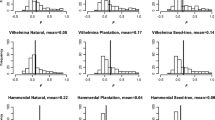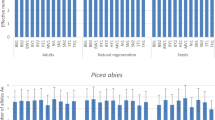Abstract
The objective of this study was to estimate the effect of pre-commercial tending and commercial thinning on the genetic diversity parameters, especially rare allele loss and diameter–heterozygosity associations, in Scots pine stands by retrospectively modelling the removal of inferior/superior trees. Modelling was based on empirical data of DNA polymorphism in (a) a 60-year-old natural stand and (b) a 20-year-old young stand planted with seeds collected in a seed orchard. Within each of these stands, approximately 400 trees were systematically sampled within 1-ha plots (800 trees in total) and genotyped at 5 neutral and 7 EST-derived nuclear microsatellite markers. There was no significant association between heterozygosity, common allele number and tree diameter in either stand. Even at a high intensity, both simulated tending and commercial thinning had minor effects on the heterozygosity and allelic diversity but caused a significant loss of rare alleles. However, there was a nonlinear relationship between the loss of rare alleles and the thinning intensity in the young stand, such that below 30 % thinning intensity, the rare alleles were lost at a markedly lower rate. In conclusion, the association between commercial value and genetic diversity is weak in Scots pine. Thinning causes loss of rare alleles; however, for specific cases, it could be possible to identify the margins for a slow rate of rare allele loss.







Similar content being viewed by others
References
Abrahamsson S, Ahlinder J, Waldmann P, Garcia-Gil MR (2013) Maternal heterozygosity and progeny fitness association in an inbred Scots pine population. Genetica 141:41–51
Belletti P, Ferrazzini D, Piotti A, Monteleone I, Ducci F (2012) Genetic variation and divergence in Scots pine (Pinus sylvestris L.) within its natural range in Italy. Eur J Forest Res 131:1127–1138
Buiteveld J, Vendramin GG, Leonardi S, Kamer K, Geburek T (2007) Genetic diversity and differentiation in European beech (Fagus sylvatica L.) stands varying in management history. For Ecol Manag 247:98–106
Chapuis M, Lecoq M, Michalakis Y, Loiseau A, Sword GA, Piry S, Estoup A (2008) Do outbreaks affect genetic population structure? A worldwide survey in Locusta migratoria a pest plagued by microsatellite null alleles. Mol Ecol 17:640–3653
Chudzińska E, Diatta JB, Wojnicka-Półtorak A (2014) Adaptation strategies and referencing trial of Scots and black pine populations subjected to heavy metal pollution. Environ Sci Pollut R 21(3):2165–2177
Chybicki IA, Dzialuk M, Trojankiewicz M, Slawski M, Burczyk J (2007) Spatial genetic structure within two contrasting stands of Scots pine (Pinus sylvestris L.). Silvae Genet 57:4–5
Danusevicius D (2008) Hybrid vigour from intra-specific crosses of Scots pine. Balt For 14(1):2–6
Deng HW, Fu YX (1998) Conditions for positive and negative correlations between fitness and heterozygosity in equilibrium populations. Genetics 148:1333–1340
Dounavi KD, Steiner W, Maurer WD (2002) Effects of different silvicultural treatments on the genetic structure of European beech populations (Fagus sylvatica L.). In: von Gadow K, Nagel J, Saborowski J (eds) Continuous cover forestry: assessment, analysis, scenarios. Kluwer Academic Publishers, Dordrecht, pp 81–90
Dumolin S, Demesure B, Petit RJ (1995) Inheritance of chloroplast and mitochondrial genomes in pedunculate oak investigated with an efficient PCR method. Theor Appl Genet 91:1253–1256
Elsik CG, Minihan VT, Hall SE, Scarpa AM, Williams CG (2000) Low-copy microsatellite markers for Pinus taeda L. Genome 43:550–555
Finkeldey R, Ziehe M (2004) Genetic implications of silvicultural regimes. For Ecol Manag 197:231–244
Garcia-Gil MR, Olivier F, Kamruzzahan S, Waldmann P (2009) Joint analysis of spatial genetic structure and inbreeding in a managed population of Scots pine. Heredity 103:90–96
Garcia-Gil MR, Floran V, Östlund L, Mullin TJ, Andersson Gull B (2015) Genetic diversity and inbreeding in natural and managed populations of Scots pine. Tree Genet Genom. doi:10.1007/s11295-015-0850-5
Geburek T, Müller F (2005) How can silvicultural management contribute to genetic conservation?. Arbora Publishers, Zvolen, pp 3–8
Hale ML, Burg TM, Steeves TE (2012) Sampling for microsatellite-based population genetic studies: 25 to 30 individuals per population is enough to accurately estimate allele frequencies. PLoS ONE 7(9):e45170
Hertel H, Kaetyel R (1999) Susceptibility of Norway Spruce Picea abies (L.) Karst clones to insects and roe deer in relation to genotype and foliar phytochemistry by phyton (Austria). Phyton 39(4):65–72 (special issue “Eurosilva”)
Hoffmann AA, Sgro CM (2011) Climate change and evolutionary adaptation. Nature 470:479–485
Hosius B, Leinemann L, Konnert M, Bergmann F (2006) Genetic aspects of forestry in the Central Europe. Eur J For Res 125:907–913
Hussendorfer E, Konnert M (2000) Investigations of genetic variation of silver fir (Abies alba Mill) in uneven-aged forests (“Plenterwald”) in comparison with even-aged forests (“Altersklassenwald”). Forstwiss Cent 119(4):208–225
Katzel R, Nordt B, Schmitt J (2001) Untersuchungen zum Einfluß der Durchforstungsintensität auf die genetische Struktur von Kiefernbeständen in den Berliner Forsten auf der Grundlage von Isoenzym-und DNA-Markern. In: Wolf H (ed) Nachhaltige Nutzung forstgenetischer Ressourcen Tagungsbericht zur 24 Internationalen Tagung der Arbeitsgem f Forstgenetik u forstpflanzenzuchtung Sachsische Landesanstalt fu¨r Forsten, Pirna, Germany, pp 159–170
Konnert M, Hosius B (2010) Contribution of forest genetics for a sustainable forest management. Forstarchiv 81:170–174
Krakau U-K, Liesebach M, Aronen T, Lelu-Walter M-A, Schneck V (2013) Scots pine. In: Luc E (ed) Forest tree breeding in Europe. Managing forest ecosystems, vol 25, Pâques, 2013. Springer, VI (chapter 6.3)
Ledig FT, Guries RP, Bonefeld BA (1983) The relation of growth to heterozygosity in pitch pine. Evolution 37:1227–1238
Macdonald SE, Thomas BR, Cherniawsky DM, Purdy BG (2001) Managing genetic resources of lodgepole pine in west-central Alberta: patterns of isozyme variation in natural populations and effects of forest management. For Ecol Manag 152:45–58
Miyamoto N, Fernández-Manjarrés JF, Morand-Prieur ME, Bertolino P, Frascaria-Lacoste N (2008) What sampling is needed for reliable estimations of genetic diversity in Fraxinus excelsior L.(Oleaceae)? Ann For Sci 65(4):403–410
Nijensohn SE, Schaberg PG, Hawley GJ, DeHayes DH (2005) Genetic subpopulation structuring and its implications in a mature eastern white pine stand. Can J For Res 35:1041–1052
Paffetti D, Travaglini D, Buonamici A et al (2012) The influence of forest management on beech (Fagus sylvatica L.) stand structure and genetic diversity. For Ecol 284:34–44
Pazouki L, Shanjani PS, Fields PD, Martins K, Suhhorutsenko M, Viinalass H, Niinemets U (2016) Large within-population genetic diversity of the widespread conifer Pinus sylvestris at its soil fertility limit characterized by nuclear and chloroplast microsatellite markers. Eur J For Res 135:161–177
Peakall R, Smouse PE (2006) GENALEX 6: genetic analysis in Excel Population genetic software for teaching and research. Mol Ecol Notes 6:288–295
Pfaffenberger RC, Patterson JH (1987) Statistical methods. Richard D. and Irvin Inc., Illinois, pp 809–817
Rajendra KC, Seifert S, Prinz K, Gailing O, Finkeldey R (2014) Subtle human impacts on neutral genetic diversity and spatial patterns of genetic variation in European beech (Fagus sylvatica). For Ecol Manag 319:138–149
Rajora OP, Rahman MH, Buchert GP, Dancik BP (2000) Microsatellite DNA analysis of genetic effects of harvesting in old-growth eastern white pine (Pinus strobus) in Ontario. Mol Ecol 9:339–348
Ratnam W, Rajora OP, Finkeldey R, Aravanopoulos F, Jean-Marc Bouvete J-M, Vaillancourt RE, Kanashirog M, Fadyh B, Tomitai M, Vinsonj Ch (2014) Genetic effects of forest management practices: global synthesis and perspectives. For Ecol Manag 333:52–65
Robichaud RL, Glaubitz JC, Rhodes OE, Woeste K Jr (2010) Genetic consequences of harvest in a mature second-growth stand of black walnut (Juglans nigra L.). Ann For Sci 67:702
Rotherham T (2011) Forest management certification around the world—progress and problems. For Chron 87(5):603–611
Savolainen O, Hedrick P (1995) Heterozygosity and fitness: no association in Scots pine. Genetics 140:755–766
Schaberg PG, DeHayes DH, Hawley GJ, Nijensohn SE (2008) Anthropogenic alterations of genetic diversity within tree populations: implications for forest ecosystem resilience. For Ecol Manag 256:855–862
Sebastiani F, Pinzauti F, Kujala ST, González-Martínez SC, Vendramin GG (2012) Novel polymorphic nuclear microsatellite markers for Pinus sylvestris L. Conserv Genet Resour 4(2):231–234
Soranzo N, Provan J, Powell W (1998) Characterization of microsatellite loci in Pinus sylvestris L. Mol Ecol 7:1260–1261
Szmidt EA, Muoana O (1985) Genetic effects of Scots pine domestication. In: Lecture notes in biomathematics, vol 60, pp 241–252
Van Oosterhout C, Hutchinson WF, Wills DPM, Shipley PF (2005) Micro-checker user guide. The University of Hull, Hull
Wolf H (2001) Auswirkungen von waldbaulichen Eingriffen auf die genetische Struktur von Durchforstungsbeständen der Fichte, Rotbuche und Stieleiche in Sachsen. In: Nachhaltige Nutzung forstgenetischer Ressourcen Tagungsbericht 24 Internationale Tagung der ARGE Forstgenetik/Forstpflanzenzüchtung, 14–16 März 2000, Pirna, pp 171–181
Yazdani R, Muona O, Rudin D, Szmidt AE (1985) Genetic structure of Pinus sylvestris seed tree stand and naturally regenerated understory. For Sci 31:430–436
Zeide B (2001) Thinning and growth: a full turnaround. Forestry 99:20–25
Ziehe M, Hattemer HH (2002) Target-diameter felling and consequences for genetic structures in a beech stand (Fagus sylvatica L.). In: von Gadow K, Nagel J, Saborowski J (eds) Continuous cover forestry. Managing forest ecosystems, vol 4. Kluwer Academic Publishers, Dordrecht, pp 91–105
Acknowledgments
This study was conducted within the framework of the Ministry of Science and Education of the Lithuanian research project No. VP1-3.1-ŠMM-08-K-01-025 entitled “Specific, genetic diversity and sustainable development of Scots pine forest to mitigate the negative effects of increased human pressure and climate change”, which was supported by the EU Social Fund.
Author information
Authors and Affiliations
Corresponding author
Additional information
Handling Editor: Miren del Rio.
Rights and permissions
About this article
Cite this article
Danusevicius, D., Kerpauskaite, V., Kavaliauskas, D. et al. The effect of tending and commercial thinning on the genetic diversity of Scots pine stands. Eur J Forest Res 135, 1159–1174 (2016). https://doi.org/10.1007/s10342-016-1002-7
Received:
Revised:
Accepted:
Published:
Issue Date:
DOI: https://doi.org/10.1007/s10342-016-1002-7




